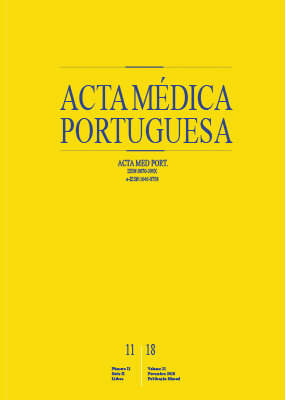Morbilidade na Prematuridade Associada a Restrição do Crescimento Fetal e nos Prematuros Leves para a Idade Gestacional: Experiência de um Centro de Referência
DOI:
https://doi.org/10.20344/amp.9599Palavras-chave:
Atraso do Crescimento Fetal, Desenvolvimento Fetal, Morbilidade, Recém-Nascido Pequeno para a Idade Gestacional, Recém-Nascido PrematuroResumo
Introdução: A prematuridade e o baixo peso ao nascer têm sido associados a maior morbilidade e mortalidade neonatais. Este estudo teve como objetivo avaliar possíveis fatores de risco para a prematuridade associada a restrição do crescimento fetal e a recém-nascidos leves para a idade gestacional e determinar a incidência da morbilidade nestes dois grupos de recém-nascidos.
Material e Métodos: Estudo caso-controlo retrospetivo dos recém-nascidos com idade gestacional inferior a 32 semanas, com o diagnóstico obstétrico de restrição do crescimento fetal e com o diagnóstico clínico de leves para a idade gestacional, internados na Unidade de Cuidados Intensivos Neonatais de um hospital terciário, durante um período de seis anos.
Resultados: Foram estudados 356 recém-nascidos, observando-se uma incidência de 11% de restrição do crescimento fetal e 18% de leves para a idade gestacional. A pré-eclâmpsia foi o fator de risco da gestação com maior significado estatístico (47% vs 16%, p < 0,001) nos recém-nascidos leves para a idade gestacional. Observou-se também, nestes recém-nascidos, maior incidência de displasia broncopulmonar ligeira (66% vs 38%, p = 0,005), de sépsis tardia (59% vs 37%, p = 0,003), de retinopatia da prematuridade (58% vs 26%, p = 0,003) e de enterocolite necrotizante (20% vs 9%, p = 0,005). A mortalidade foi idêntica nos três grupos.
Discussão: Encontraram-se menos recém-nascidos do sexo masculino diagnosticados com restrição do crescimento fetal durante a gravidez comparativamente ao sexo feminino. Observaram-se diferenças significativas no grupo destes recém-nascidos, quanto à ocorrência de corioamnionite e de pré-eclâmpsia, face ao grupo controlo. Tanto os recém-nascidos com restrição do crescimento fetal como os leves para a idade gestacional apresentaram uma pontuação mais elevada nos índices de risco clínico comparativamente ao grupo controlo. De forma global, os recém-nascidos leves para a idade gestacional tiveram maior incidência de morbilidade que os recém-nascidos com restrição do crescimento fetal e que o grupo controlo.
Conclusão: Os avanços nos cuidados intensivos neonatais diminuíram a mortalidade nos recém-nascidos prematuros. Contudo, observam-se ainda diferenças significativas na incidência da morbilidade nos recém-nascidos com compromisso do crescimento. A colaboração entre obstetras e neonatalogistas constitui a base para uma correta avaliação clínica, sinalização precoce e intervenção global sobre estes recém-nascidos, com impacto significativo no prognóstico a curto e longo prazo.
Downloads
Downloads
Publicado
Como Citar
Edição
Secção
Licença
Todos os artigos publicados na AMP são de acesso aberto e cumprem os requisitos das agências de financiamento ou instituições académicas. Relativamente à utilização por terceiros a AMP rege-se pelos termos da licença Creative Commons ‘Atribuição – Uso Não-Comercial – (CC-BY-NC)’.
É da responsabilidade do autor obter permissão para reproduzir figuras, tabelas, etc., de outras publicações. Após a aceitação de um artigo, os autores serão convidados a preencher uma “Declaração de Responsabilidade Autoral e Partilha de Direitos de Autor “(http://www.actamedicaportuguesa.com/info/AMP-NormasPublicacao.pdf) e a “Declaração de Potenciais Conflitos de Interesse” (http://www.icmje.org/conflicts-of-interest) do ICMJE. Será enviado um e-mail ao autor correspondente, confirmando a receção do manuscrito.
Após a publicação, os autores ficam autorizados a disponibilizar os seus artigos em repositórios das suas instituições de origem, desde que mencionem sempre onde foram publicados e de acordo com a licença Creative Commons









